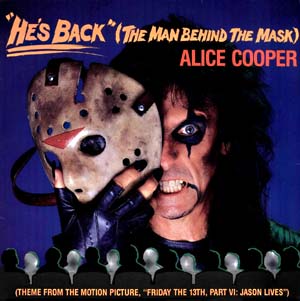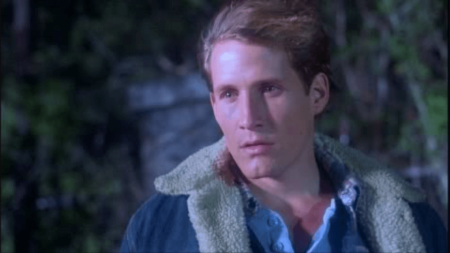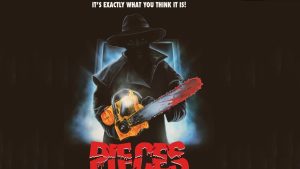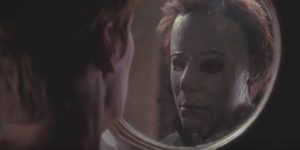Zach’s Sunday Slashers: Dying on the hill for ‘Jason Lives’
The titular Jason, played by C.J. Graham, after he is resurrected accidentally by Tommy Jarvis in “Friday the 13th, Part VI: Jason Lives.” After he is resurrected by lightning, Jason begins his rampage through the town of Forest Green, formerly known as Crystal Lake. (Courtesy of Paramount Pictures)
April 24, 2022
I can only imagine what the feeling must have been like sitting in the movie theater in 1986 to see the most recent “Friday the 13th” film. I have to assume that audiences were confused, frustrated or slightly amused as they watched Jason get brought to life like Frankenstein’s monster before he punches a man’s heart out from his chest and a James Bond-style intro sequence plays.
Like Alice Cooper said in his original song “He’s Back (The Man Behind the Mask)” which is featured in the movie’s end credits, the man behind the mask really was back and he had crawled out of his hole to terrorize moviegoers and campers in “Friday the 13th, Part VI: Jason Lives.”

(Courtesy of Universal Music Group)

If my mint-in-box collectible Jason Voorhees action figure, “F13” pajama pants and “Jason Lives” t-shirt aren’t enough to show it, let me say: I am a big fan of the “Friday the 13th” franchise. Even the worst films in the series have some level of charm and entertainment to offer, even if it’s from the “so bad it’s good” perspective (looking at you, “Jason Goes to Hell”).
While “Jason Lives” could be seen as the beginning of the series’ downfall for establishing some of its more admittedly ridiculous concepts, such as Jason being an undead zombie, I think its divisive status among fans is the result of a misunderstanding of its purpose as a film. If seen as an occasionally comical action thriller rather than a horror film, it ends up being one of the most memorable – and quotable – entries.
“Friday the 13th” is at its best when it leans into its roots as a spooky campfire story come to life, and “Jason Lives” delivers on this concept while providing a distinct B-movie feel that is palpable from the very start. Practically everything in the movie has aged like milk, which makes the entire thing feel like a hyper-stylized time capsule to the mid-1980s.
The movie opens on Tommy Jarvis (Thom Matthews) digging up the grave of Jason Voorhees in order to burn it and put his fears of the killer’s return to rest. After a conveniently-timed lightning bolt shocks Jason back to life, he dons the hockey mask (that Tommy just happened to drop into his grave) and the killing starts almost instantly after Jason punches a hole through a man’s chest and storms toward the small town of Forest Green, formerly known as Crystal Lake.
The timeline here is a little wonky since it’s meant to be a decade after Part IV despite the movie still clearly being set in the mid-1980s. Despite this, the plot fixes the main issue the previous film had, which was revealing that the killer was not, in fact, Jason by finding a way to bring him back into the story.
Where the previous movies seemed to have some sense of realism, with Jason being portrayed as a disfigured backwoods hillbilly with a grudge against horny young adults, “Jason Lives” sparked a new era for the franchise by making him an undead and completely invincible zombie with the motor skills of Frankenstein’s monster.
C.J. Graham plays Jason with a decent amount of power and energy that makes him as intimidating as he should be, though he lacks the same presence Kane Hodder, the best person to ever wear the hockey mask, would later have in the next four films.
As a matter of fact, Jason is not the only one who got a total makeover in this movie. Thom Matthews’ Tommy Jarvis is a far cry from his portrayal in the previous two films, having undergone a transformation from a four-eyed geek who makes horror masks to a total heartthrob who wears denim jackets and definitely listens to Guns ‘n Roses.

(Photo courtesy of Paramount Pictures)
Tommy’s new look extends to his personality, as he makes constant one-liners and is so confident that Megan, the sheriff’s daughter and the movie’s main love interest, falls for him almost immediately after they meet(apparently the fact that he just escaped a psychiatric hospital wasn’t a red flag for her).
The chemistry between Tommy and Megan is straight out of “The Breakfast Club,” and their relationship is full of cartoony romantic interactions. . My favorite part is when the two drive backwards to evade the police and Megan shoves Tommy’s face into her crotch while she conveniently hits every bump and sharp turn on the road.
If the ridiculous setup for the plot wasn’t enough to set the tone for how funny the movie is at times, the scene of Jason getting splattered with a paintball in self defense after he decapitates two people in one swing of his machete should.
If that doesn’t work, how about the oversized red dot sight the deputy has on his revolver, which leads the way for my favorite line of dialogue in the entire franchise:
“Wherever the red dot goes…ya bang!”
Finally, try adding cartoon sound effects to the scene of Jason rolling down a hill after getting blasted with a shotgun andgetting up unscathed and see if that doesn’t elicit a chuckle.
It doesn’t help that, aside from an astounding score by series regular composer Harry Manfredini, the movie’s entire soundtrack consists of hilariously unfitting Alice Cooper songs such as “Teenage Frankenstein.”
As scarce as they are, the suspenseful moments in “Jason Lives” still make sure to remind viewers what genre they are watching.
One specific scene comes to mind where a couple drives away in their trailer with loud music playing as the girl stumbles around in the back as every camera shot seems to imply that Jason could appear at any moment and another scene later in the movie where Jason peers over a small girl’s face as she says a prayer for her life.
What makes these few scenes even more suspenseful is Manfredini’s iconic score, with its loud symphonic pieces that help to elevate the film to something almost resembling a genuine horror film at times.
Just when it seems like the film might actually be taking itself seriously, though, it ends abruptly after Tommy buries Jason back where he first drowned in the bottom of Crystal Lake. He and Megan embrace, Jason opens his eyes suddenly and…the credits roll as Alice Cooper’s corny ode to Jason Voorhees warns viewers that he is back once again, “and he’s after your soul…”







































































































































